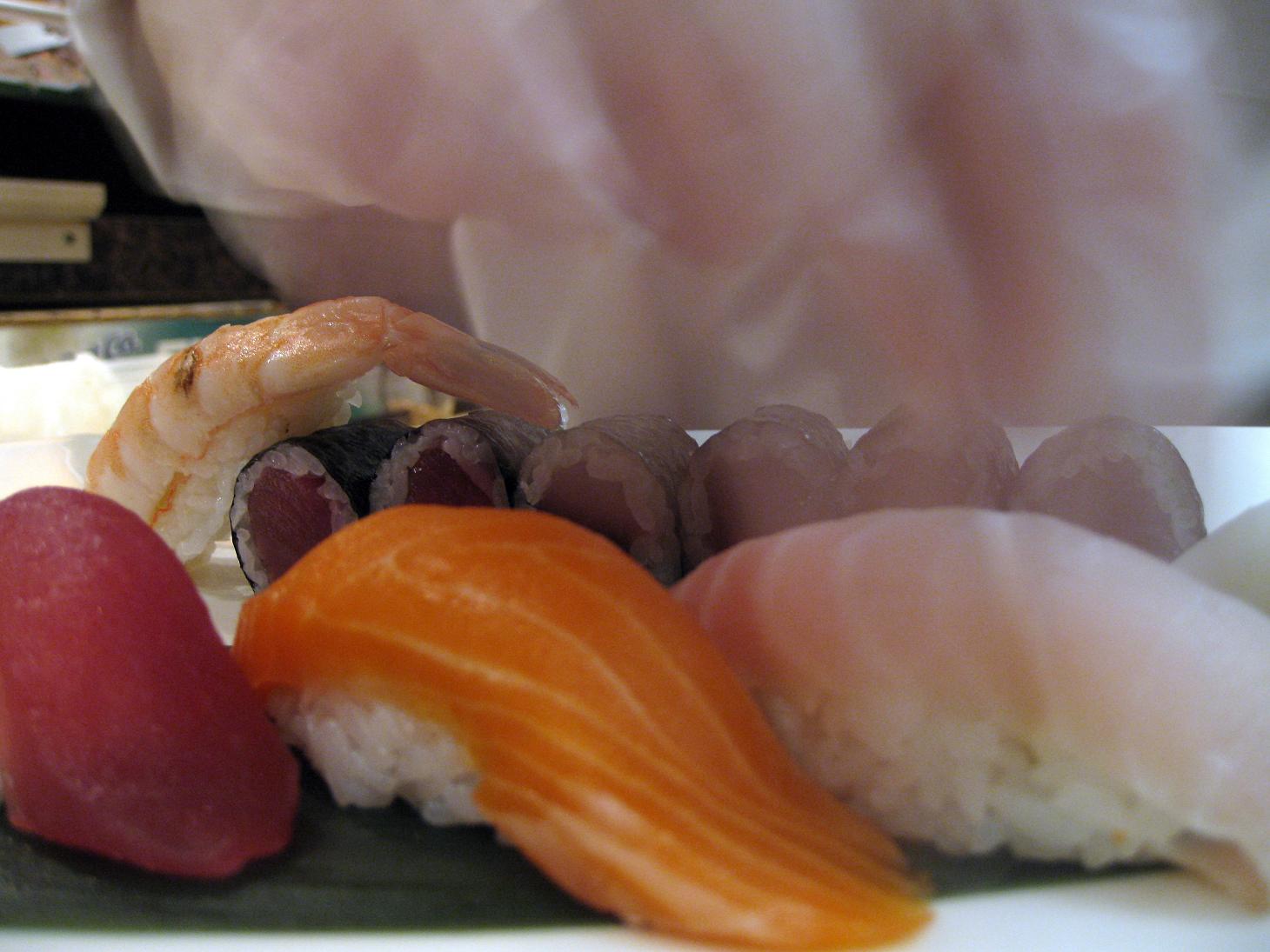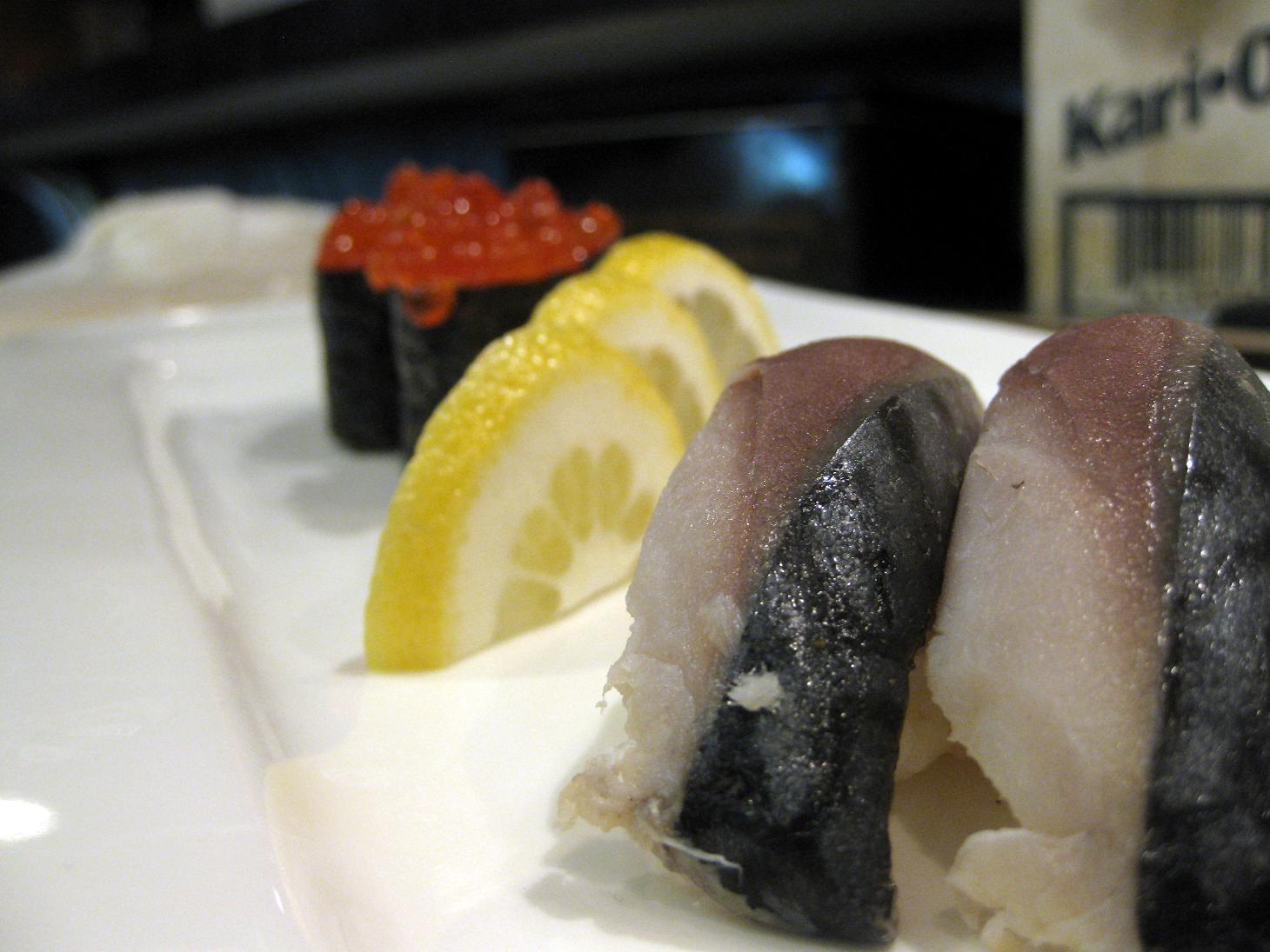He wants to build his vocabulary and improve his grammar. So we don’t say much in way of conversation as I stand to his left, his wakiitai, his side-cutting board. Instead, we practice expressions while taking turns scooping rice from the Zujirushi rice warmer, pressing fluffy mound onto nori.
Broke, I say.
“Bloke.”
Broke, I repeat.
“Bloke. Bloke down.”
I nod my head. But broke down, you can only use that when you’re talking about your car. Everything else, you just say broke, I say in Chinese.
“Yeah, car bloke down,” he says. Then he points to an imaginary object on the table between us. “This is bloke.”
I nod again. I look down at our cutting boards, comparing my nori to his. On one, the rice is pulled across unevenly, with miniature mounds and valleys extending across the green plain. That one isn’t Michael’s.
His long, unconditioned hair lies flat against his bowed head as he works. The way he parts it – straight down the middle – makes his oval shaped face appear even rounder. Small, squinty eyes peer at the roll that’s quietly emerging from his gloved-handiwork. He starts piling on thin slices of cucumber.
“‘What do you think?’” he says to himself, slowly. His teeth are jagged, and there is plenty of space in between to work with. “‘How do you like it?’” He has an accent, but the meaning is clear. We focus on phrases he can directly apply while behind the sushi bar. The better he communicates to patrons at the bar, the better tips he’ll make.
Peering through the glass and rows of raw fish filets filed neatly one after another, the whole restaurant looks different. Facing out from behind the cutting board puts you on stage, an actor in his craft. Suddenly, you’re conscientious of your every move.
Everyone’s staring at you, the voice in your head reminds you.
Don’t pick your nose, it says. Don’t scratch your ass.
The attention doesn’t make learning any easier. Fortunately, Michael’s a patient teacher. He watches carefully, correcting the ingredients you’re placing in the roll when necessary, adjusting your form when it’s incorrect. Most importantly, he lets you make mistakes. It might be solely to give himself a good laugh, which he does nothing to hide: it’s open mouthed and barking, and there’s a twinkle in his eyes. It never feels like he’s laughing at you, though, only with you. You smile because he’s smiling. His laughter never makes you want to quit. He never laughs to flaunt his superiority.
“Inside out,” he says when he sees me building the roll with the seaweed oriented in reverse; placing the kani, avocado, and cucumber on the rice, instead of flipping it over and putting it on the seaweed. What the hell? I mutter to myself Fukinese, an expression he taught me. He chuckles.
“No no no,” he’ll scold when he watches me hack at the completed roll, butchering them into eight pieces. He pushes me aside. He shows me how it’s done; back and forth like a saw, but using speed to make the cut clean, crisp. It’s three quick movements: slice forward with knife tilted up, slide back with knife tilted down, then flat and pulled backwards as the knife strikes the cutting board.
After three sessions of practicing rolls, I ask him to show me how to do sushi.
“Qi sing,” he says in Chinese, with an incredulous look. It means “crazy.” When you train to be a sushi chef, he says, you spend weeks just doing side work, and if you’re talented, maybe rolling California rolls. Only when you master California rolls are you allowed to make rolls with fish, then after a few more weeks, the more difficult rolls – seaweed-outside and Chef Special Rolls.
I remember Danny, our previous sushi chef, saying something similar – except his training was underneath a Japanese chef, and more rigorous. For one month, Danny only cut cucumbers. They were the only things he was allowed to take a knife to, but he did it for 2 or 3 hours a day, everyday. He cut around the circumference, opening up the vegetable into one long sheet. Then he piled 5 or 6 of the sheets atop one another, and sliced them paper thin for the head sushi chef to use. That was it for the cutting for the rest of the day – then back to standing on the sidelines, watching, or washing dishes.
Yet here I was, asking Michael to teach me despite barely being able to cut properly; or knowing all the ingredients in all the rolls; or still forgetting, at times, which rolls were seaweed-inside or seaweed-outside.
For whatever reason, though, when the next order for sushi came through the printer, he signals me to follow along with what he’s doing. He cuts two pieces of fish – mackerel – and puts one down on my cutting board. With one hand, he reaches into the warmer and plucks out a small morsel of rice. His fingers deftly roll the morsel into his palm, around and around, until it’s spherical. He hands it to me. “This much,” he says, then tells me to try.
I pick up what I imagine is an equal amount.
“No,” he plucks a chunk of rice from the amount I grabbed. “Too much.”
I try again.
“No,” he repeats. He removes another chunk.
On the third try, he approves, and I start rolling the rice between my fingers. I resist the urge to put the morsel on the cutting board to shape it into a ball, like Play-Doh.
He shows me how to hold the fish gently in the left hand, then press the rice onto the bottom, using two fingers to flatten the base of the rice, nestling it into the fish. “Gentle,” he says in Chinese. “Don’t use too much pressure. Very soft.” I imitate his motions. His left hand cupping the fish gives the sushi its rounded figure.
He flips the product over in his hand, with the rice pressed into it. Using his thumb and index finger, he squares off the fish, ensuring every grain is covered evenly, save a thin white line at the very bottom.
He pulls out a dish and plates it; the mackerel looks pristine on the clean white, perfectly sized and proportioned, a gentle, gleaming curve hugging the rice.
I follow suit, and put my mackerel sushi next to his. He laughs – no attempt to hide it. It’s lopsided, the fish slipping off the rice on one side. There looks to be enough rice to engulf the entire fish. The symmetrical culinary masterpiece next to it magnifies the sloppiness.
“No good-uh,” he says. He picks it up, and starts fixing it, laughing as he does so. “Qi sing.”
Photo Credit: frank_breech


